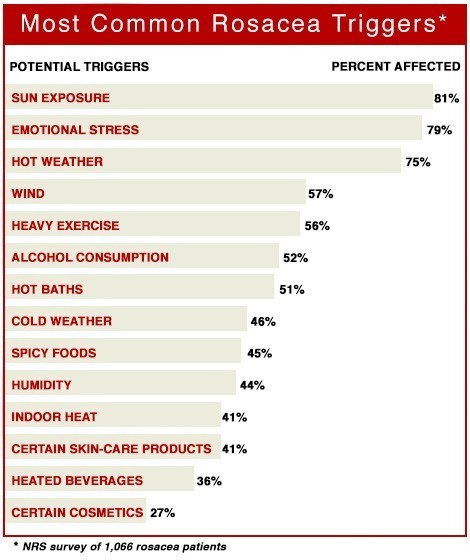What is Rosacea and How Can You Manage It?
2nd Apr 2018
If you have persistent, annoying patches of redness and bumps on your face, you might have rosacea. It usually begins during teens or 20s and can become worse into a person's 30s or 40s. The cause of rosacea is still not entirely known, though there are many contributing factors.
This condition can be a real bummer to your beauty routine, but take heart; there are easy, effective ways to treat it, manage it and reduce its appearance.
Symptoms of Rosacea
Most people associate rosacea with having a red, “flushed” face, but for many sufferers the symptoms go way beyond facial redness. Rosacea can manifest on the neck, chest, ears and scalp. As it progresses, the blood vessels can thicken and swell. It can affect the eyes as well, causing pain and irritation wherever it manifests.
The symptoms of rosacea include:
- Redness
- Bumps resembling acne
- Overly oily skin
- Burning
- Stinging
- Swelling
- Rough, dry skin patches
- Enlarged pores
- Easily blushing when embarrassed
- Ruptured blood vessels
- Vision problems (due to inflammation)
In addition to the physical symptoms, rosacea can also take a serious psychological toll. The National Rosacea Society conducted a survey and found that over 90 percent of rosacea patients said that their condition had lowered their self-confidence / self-esteem, and 41 percent reported that it had caused them to avoid public contact or cancel social plans. Eighty eight percent of rosacea patients surveyed with severe symptoms said that the problem hurt their professional interactions, and over 50 percent admitted they had even skipped work because of their skin issues.
Instagram @talontedlex | Beauty Guru and Rosacea Sufferer
Follow her Instagram for great makeup, skincare, and lifestyle tips for people with rosacea.
Rosacea has no known cause, but some of the factors that can trigger it are:
- Genetics/heredity
- Sun exposure/damage
- Emotional stress
- Skin care products
- Blood vessel dilation from medications
- Bacteria, specifically H. pylori
- Alcohol
- Heavy exercise
- Smoking
- Food Allergies or spicy foods
- Environmental irritation
The National Rosacea Society asked 1,066 rosacea patients what their triggers were and found as follows:

Generally, fair-skinned women with light hair and blue eyes between the ages of 30 and 50 are the most prone to rosacea. Rosacea symptoms can come and go seemingly without warning.
Treating and Managing Rosacea
Unfortunately, there is no cure for rosacea. However, there are ways to manage it so that you don’t trigger an outbreak.
“Perhaps the best news is that increased options for medical therapy are now available to keep the signs and symptoms of rosacea under control,” says Dr. Julie Harper, clinical associate professor of dermatology, University of Alabama-Birmingham.
Some of the medicines on the market that can help with treating rosacea include:
Doxycycline and Metronidazole (Flagyl). These are antibiotics that kill skin bacteria and reduce swelling and redness.
Brimonidine (Mirvaso). This gel tightens up blood vessels and reduces redness.
Azelaic acid. This treatment is available in a gel or foam and helps relieve redness and swelling while clearing up the bumps.
Isotretinoin (Claravis, Amnesteem). These acne drugs can clear up rosacea skin bumps; however, you shouldn’t use it if you’re pregnant or looking to become pregnant.
It can take weeks or months for these medications to have an effect. Additional treatments and processes that can make a difference include:
Laser therapy. Reduces the appearance of blood vessels.
Dermabrasion. This treatment gently sands off the top layer of skin and reduces the appearance of rosacea once the skin heals.
Electrocautery. Employs the use of an electric current to remove damaged blood vessels.
In addition to these medical interventions, there are some things you can do on your own. First of all, determine the outside factors that tend to trigger your rosacea, and take steps to avoid them. Some of the most common rosacea triggers include:
- Sun exposure
- Hot or cold temperatures
- Wind
- Spicy foods
- Alcohol
- Physical activity
- Topical medications
- Skin products that contain chemicals
To reduce rosacea outbreaks, protect your skin by always wearing sunscreen. Reduce harsh weather exposure and use products that are safe and gentle on your skin. Be sure to select skin care products and cosmetics that are chemical-free, alcohol-free, fragrance-free, all-natural and organic if possible.
Minimalist, Non-Toxic Beauty Products
The right makeup and skin care can help to reduce the appearance of rosacea as well. It is extremely important to use minimalist, natural cosmetics that will not further irritate your skin.
During the day, apply a sunscreen with SPF 30 or greater whose only active sunscreen ingredients are titanium dioxide and/or zinc oxide. People with rosacea are often sensitive to chemical sunscreens which are in the majority of skincare products, so be sure to check labels. Try a mineral powdered foundation with the sunscreen actives titanium dioxide and/or zinc oxide to protect skin from the sun's irritating rays and help neutralize/cover redness.

